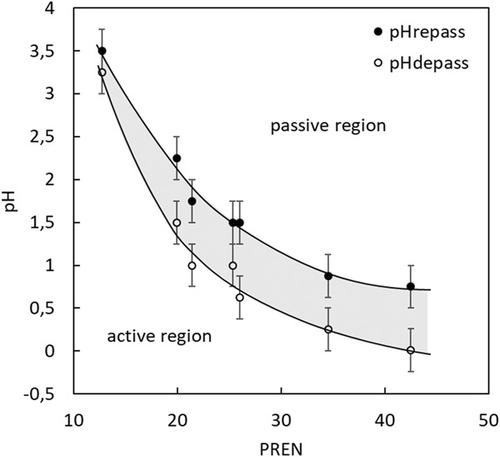当前位置:
X-MOL 学术
›
Mater. Corros.
›
论文详情
Our official English website, www.x-mol.net, welcomes your
feedback! (Note: you will need to create a separate account there.)
Depassivation and repassivation of stainless steels by stepwise pH change
Materials and Corrosion ( IF 1.6 ) Pub Date : 2020-10-02 , DOI: 10.1002/maco.202011985 Emir Mujanović , Bojan Zajec 1 , Andraž Legat 1 , Tadeja Kosec 1 , Janez Kovač 2 , Gregor Mori 3 , Stefan Hönig 4 , Gerald Zehethofer 4
Materials and Corrosion ( IF 1.6 ) Pub Date : 2020-10-02 , DOI: 10.1002/maco.202011985 Emir Mujanović , Bojan Zajec 1 , Andraž Legat 1 , Tadeja Kosec 1 , Janez Kovač 2 , Gregor Mori 3 , Stefan Hönig 4 , Gerald Zehethofer 4
Affiliation

|
Immersion tests with different stainless steels have been performed, while the pH was stepwise decreased and then increased again. During 8.5‐day exposure, the depassivation and repassivation pH values as a function of pitting resistance equivalent number were determined. There is always a gap between both pH values (depassivation and repassivation), indicating that for every steel, there are conditions where an existing passive layer can be maintained but cannot be rebuilt after depassivation. In such environments, the passive layer is thicker, consisting mainly of molybdenum and iron rich oxides, while chromium is dissolved. Usually, depending on conditions, the passive layer is more chromium‐rich, especially the inner layer. This is relevant, for example, for acidizing jobs in oil and gas industry, proving that repassivation after acidizing will happen promptly, when the pH is increased again.
中文翻译:

通过逐步改变pH值对不锈钢进行去钝化和再钝化
已经进行了用不同不锈钢进行的浸入测试,而pH逐渐降低,然后再次升高。在8.5天的暴露过程中,确定了钝化和再钝化的pH值与抗点蚀当量的关系。在两个pH值之间(去钝化和再钝化)之间始终存在间隙,这表明对于每种钢,在某些条件下可以保留现有的钝化层,但是在钝化后无法重建。在这种环境下,钝化层较厚,主要由钼和富铁氧化物组成,而铬溶解了。通常,根据条件的不同,钝化层的铬含量更高,尤其是内层。例如,这与石油和天然气行业的酸化工作有关,
更新日期:2020-10-02
中文翻译:

通过逐步改变pH值对不锈钢进行去钝化和再钝化
已经进行了用不同不锈钢进行的浸入测试,而pH逐渐降低,然后再次升高。在8.5天的暴露过程中,确定了钝化和再钝化的pH值与抗点蚀当量的关系。在两个pH值之间(去钝化和再钝化)之间始终存在间隙,这表明对于每种钢,在某些条件下可以保留现有的钝化层,但是在钝化后无法重建。在这种环境下,钝化层较厚,主要由钼和富铁氧化物组成,而铬溶解了。通常,根据条件的不同,钝化层的铬含量更高,尤其是内层。例如,这与石油和天然气行业的酸化工作有关,











































 京公网安备 11010802027423号
京公网安备 11010802027423号